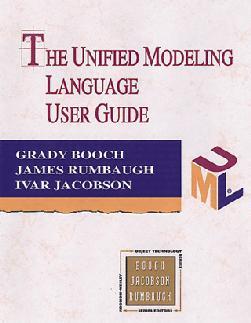

This book is intended to be read by people involved in the production of object-oriented software systems.

Authors: Grady Booch, James Rumbaugh and Ivar Jacobsen
Publisher: Addison-Wesley Publishing Co.
URL: www.awl.com
Price: $47.95
ISBN: 0-201-57168-4
Reviewer: Geoff Glasson
The preface of The Unified Modeling Language User Guide states:
The Unified Modeling Language (UML) is a graphical language for visualizing, specifying, constructing and documenting the artifacts of a software-intensive system. The UML gives you a standard way to write a system's blueprints, covering conceptual things, such as business processes and system functions, as well as concrete things, such as classes written in a specific programming language, database schemas, and reusable software components.
The book is divided into three major sections: structural modeling, behavioral modeling and architectural modeling. The structural and behavioral modeling are then subdivided into basic and advanced sections. Each section is laid out in a manner such that you can read the entire section (as I did) or only those parts that are important to you.
The basic structural modeling section describes the use of classes, relationships and class diagrams. It provides the basics which all object-oriented software engineers require to build UML models. Classes are described down to their lowest level, and subsections show how to distribute the responsibilities of a system among the classes that compose it. The advanced section expands on this to describe how to model the semantics of a class, object diagrams, packages, relationships and interfaces. This section shows how to model the relationships between classes and how to model the interfaces provided by a group of classes. It also teaches how to model a set of objects and their relationships at a given point in time using object diagrams.
The basic behavioral modeling section describes how to model the interaction between objects. It describes the interaction, use case and activity diagrams which dictate how the objects in the model interact with each other. The advanced behavioral modeling section also describes how to model events, state machines, processes, threads and time constraints. This book contains a wealth of information for the modeling of the structure and behavior of classes and objects. The authors show how to use state diagrams to model the behavior of individual objects within the system, showing how an object responds to internal and external stimuli. The examples start at simple state diagrams and continue through to complex diagrams that contain states and substates (states within states).
The architectural modeling section describes how to use the UML to document the physical arrangement of the software system. It deals with the complex issue of managing the components of the final product as well as how those components are deployed when the software is installed, using component and deployment diagrams. A component diagram graphically depicts the components that comprise the software; similarly, the deployment diagram describes how the components are distributed across one or more systems and how the hardware components are interconnected.
The authors have gone to great lengths to produce a readable book full of examples and useful tidbits. Try not to be overwhelmed by the volume of information in this book—much information is there, but it is all aimed at helping you model systems more accurately, and thereby design and implement better systems.
In my opinion, this book is a great addition to every object-oriented software developer's library, because it contains a great deal of information about how to model software systems. Although I have used both the Booch method and UML for some time now, I learned many things that improved the quality of my designs, especially in the area of communicating these designs to others. It is a book worth buying.